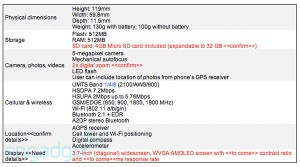When Google released its flagship smartphone product the Nexus One, it received rave reviews and has continued to be a player on the portable device market. Now two models removed from the original, we see how the Nexus One stacks up against the yet to be released Nexus Prime.
Dimensions and Form
• Google Nexus One – 119 x 59.8 x 11.5mm, 130g
• Google Nexus Prime – Unreleased
The minimalist shape and chrome build of the Nexus One has been a popular aesthetic with many critics. The screen uses up the majority of space, and this always improves the look of portable devices. The touch-sensitive buttons and fluid track ball juxtapose nicely with the overall countenance. It’s patently obvious that Google is fond of the design, as the Nexus Prime shows little alteration in this regard.
Winner: Draw
Display Screen
• Google Nexus One – 3.7 inch AMOLED capacitive touchscreen, 480×800 pixel resolution
• Google Nexus Prime – 4.7 inch, 1280 x 720 pixel resolution with Samsung PenTile Matrix Technology
While the builds are similar, the Nexus Prime’s significantly larger screen sets it apart from the Nexus One. Despite the quality of the Nexus One’s 252 pixel per inch AMOLED screen, it is hard pressed to compete with what is rumored to be the first 720p smartphone. Other features likely to be included are multi-touch and an accelerometer sensor.
Winner: Google Nexus Prime
Processing Power and Memory
• Google Nexus One – 1GHz Qualcomm Scorpion processor with Adreno 200 GPU, 512MB RAM
• Google Nexus Prime – 1.5GHz dual core TI OMAP4460 CPU and a PowerVR SGX540 GPU, 1GB RAM
The Nexus One was potent for its time, backing its 1GHz Scorpion processor with an Adreno 200 GPU and 512MB of RAM. Yet as we begin to see dual core processors become standard in tablets, it isn’t surprising that the architecture would eventually find its way to smartphones. The Nexus Prime is said to boast a brawny 1.5GHz dual core TI OMAP4460 processor supplemented by a PowerVR SGX540 GPU and 1GB RAM, revolutionary for a device that fits in the palm of your hand.
Operating System
• Google Nexus One – Android 2.4 Gingerbread
• Google Nexus Prime – Android Ice Cream Sandwich
The Nexus Prime once more is the beneficiary of a next generation upgrade, as the smartphone will roll out with the much anticipated Android Ice Cream Sandwich. Currently, the Nexus One runs Android 2.4 Gingerbread, yet it too will reportedly be upgrading to the next generation software.
Designed for both tablets and smartphones, Google has stated that Ice Cream should end the fragmentation that has occurred with its various iterations such as Gingerbread and Honeycomb. Ice Cream combines the best of these operating systems in a more efficient, app and multi-tasking friendly experience, including enhanced Javascript and Open GL graphics acceleration. Browsing promises to be much smoother than on the clunkier Gingerbread, and Google has also indicated Ice Cream will have voice and facial detection software included.
Winner: Draw
Camera
• Google Nexus One – 5 MP primary camera
• Google Nexus Prime – 5 MP primary camera with 2560 x 1920 pixel resolution, 2 MP secondary camera
The Nexus Prime is reported to have a 5 megapixel primary camera that is capable of full 1080p HD video capture. In addition, the camera should come equipped with the usual features, such as auto-focus, digital zoom, and a secondary camera for video calling, but the video capture is DVD quality.
Winner: Google Nexus Prime
Conclusion
As the newer model, the Google Nexus Prime is naturally the more advanced device. Yet the difference between the two models is staggering, considering the dual core processor, the 720p display, and the 1080p video capture in the Nexus Prime. For Nexus One owners, truly this is a case where the cost of an upgrade is justified.
Article written by Sarah Richards from MobileBroadband.net. Sarah writes on a wide range of broadband topics including 3 broadband reviews.


